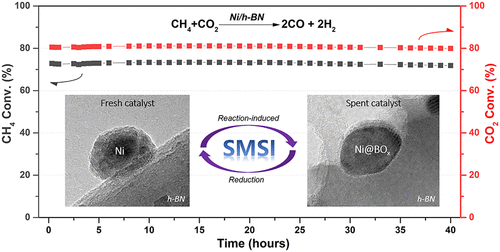当前位置:
X-MOL 学术
›
J. Am. Chem. Soc.
›
论文详情
Our official English website, www.x-mol.net, welcomes your
feedback! (Note: you will need to create a separate account there.)
Reaction-induced strong metal-support interactions between metals and inert boron nitride nanosheets
Journal of the American Chemical Society ( IF 14.4 ) Pub Date : 2020-09-14 , DOI: 10.1021/jacs.0c08139 Jinhu Dong 1 , Qiang Fu 1, 2 , Haobo Li 1 , Jianping Xiao 1 , Bing Yang 2 , Bingsen Zhang 3 , Yunxing Bai 1 , Tongyuan Song 1 , Rankun Zhang 1 , Lijun Gao 1 , Jun Cai 4, 5 , Hui Zhang 4, 5 , Zhi Liu 4, 5 , Xinhe Bao 1, 2
Journal of the American Chemical Society ( IF 14.4 ) Pub Date : 2020-09-14 , DOI: 10.1021/jacs.0c08139 Jinhu Dong 1 , Qiang Fu 1, 2 , Haobo Li 1 , Jianping Xiao 1 , Bing Yang 2 , Bingsen Zhang 3 , Yunxing Bai 1 , Tongyuan Song 1 , Rankun Zhang 1 , Lijun Gao 1 , Jun Cai 4, 5 , Hui Zhang 4, 5 , Zhi Liu 4, 5 , Xinhe Bao 1, 2
Affiliation

|
Encapsulation of metal nanocatalysts by support-derived materials is well known as the classical strong metal-support interaction (SMSI) effect that occurs almost exclusively with active oxide supports and often blocks metal-catalyzed sur-face reactions. In the present work this classical SMSI process has been surprisingly observed between metal nanoparti-cles e.g. Ni, Fe, Co, and Ru and inert hexagonal boron nitride (h-BN) nanosheets. We find that weak oxidizing gases such as CO2 and H2O induce the encapsulation of nickel (Ni) nanoparticles by ultrathin boron oxide (BOx) overlayers derived from the h-BN support (Ni@BOx/h-BN) during dry reforming of methane (DRM) reaction. In-situ surface characteriza-tions and theory calculations reveal that surface B-O and B-OH sites in the formed BOx encapsulation overlayers work synergistically with surface Ni sites to promote the DRM process rather than blocking the surface reactions.
中文翻译:

金属与惰性氮化硼纳米片之间反应诱导的强金属-载体相互作用
载体衍生材料对金属纳米催化剂的封装是众所周知的经典强金属-载体相互作用 (SMSI) 效应,该效应几乎只发生在活性氧化物载体上,并且通常会阻止金属催化的表面反应。在目前的工作中,在金属纳米颗粒(例如 Ni、Fe、Co 和 Ru)与惰性六方氮化硼 (h-BN) 纳米片之间惊人地观察到了这种经典的 SMSI 过程。我们发现,在甲烷干重整过程中,CO2 和 H2O 等弱氧化性气体会诱导镍 (Ni) 纳米颗粒被源自 h-BN 载体 (Ni@BOx/h-BN) 的超薄氧化硼 (BOx) 覆盖层包裹。 DRM) 反应。
更新日期:2020-09-14
中文翻译:

金属与惰性氮化硼纳米片之间反应诱导的强金属-载体相互作用
载体衍生材料对金属纳米催化剂的封装是众所周知的经典强金属-载体相互作用 (SMSI) 效应,该效应几乎只发生在活性氧化物载体上,并且通常会阻止金属催化的表面反应。在目前的工作中,在金属纳米颗粒(例如 Ni、Fe、Co 和 Ru)与惰性六方氮化硼 (h-BN) 纳米片之间惊人地观察到了这种经典的 SMSI 过程。我们发现,在甲烷干重整过程中,CO2 和 H2O 等弱氧化性气体会诱导镍 (Ni) 纳米颗粒被源自 h-BN 载体 (Ni@BOx/h-BN) 的超薄氧化硼 (BOx) 覆盖层包裹。 DRM) 反应。











































 京公网安备 11010802027423号
京公网安备 11010802027423号